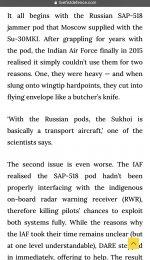Your evaluation of the Chinese Flanker fleet is also wrong. If you simply compare the performance of the fighters, I think the SU30MKI is roughly equivalent to the J11B. First of all, although the NO11M radar is PESA, according to the information I have at hand, the average power is 1.6KW and the peak power is 6.5KW. .Its power is only about 30% of the power of NO35
View attachment 22724
According to Sukhoi's data, the target detection distance of RCS=3 is 110KM, which is similar to the performance of F15C's APG63 (v1) and J11B's 1493 radar.
View attachment 22725
As for PL12 and R77, according to the Chinese pilot's speech to the Sino-Thai military exercise, the performance of PL12 is similar to that of AIM120C5, better than that of R77 and R27
As for WVR, although SU30MKI uses canard (to be precise, three-wing surface) TVC, but su30 ignores one of the most important issues, weight, according to this picture, SU30MKI weight is 18400KG, while SU27UK is 16870KG, and J11B passes The radar was replaced, composite materials were used, and the su27UK was reduced by 600KG, and the thrust of the two engines was the same, which led to a slight advantage of the J11B in the air battle between the two.
View attachment 22726







